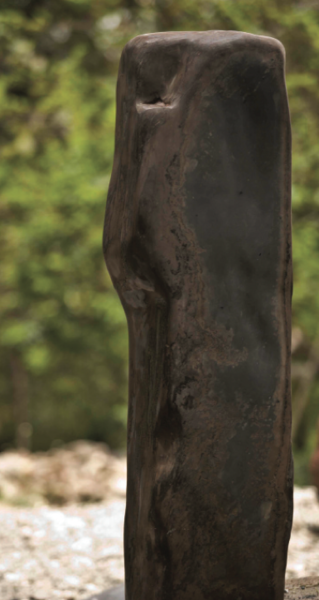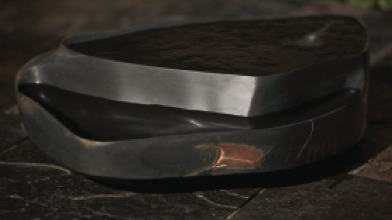Hugo Zapata
“THE ETERNAL RETURN”
Principle without speech
Principle of all principle
Return to the principle
Reverberating at a level above
Always on the vibration of the Unique
Attuned to all in depth
In intimate union
Embracing
In efforts to still more broadly embrace
The cloud of being condenses
Coils
Cosmos -Universe
Cosmos of the Uuniverse of the ‘self’
Knowledge. (Participating knowledge.)
Immensifying illumination where all with all
Enters into contemplated resonance
Above geometries, geometry,
Lines, like slow-motion radiations
Insisting, clairvoyant
Charged with the occult
Design for the return of the absolute
Design-destiny.
Henri Michaux (1)

Hugo Zapata is a dreamer of utopias who, by dint of holding a dialogue with the earth, suddenly found himself talking to the cosmogony of the Incas, the Mayas and the Aztecs.
As his creative point of departure, Hugo Zapata has planted a rock garden in his home-studio in the suburbs of Medellín. These rocks connect him to the purposes of the cosmos. They await their turn, for Hugo Zapata will discover their hidden treasure, the secret of a brightness, the shadow of a penumbra or the trajectory of a light ray concealed by the geology of the landscape.
All the rocks have an initial shape. Such is the premise of the dialogue that Hugo Zapata establishes with nature. He looks for encrypted cosmogonic messages because he knows that the seeds in his garden contain petrified dialogues charged with a millennary distance between Mars and Jupiter and The Earth. The concept that the Earth is composed mainly by water, with a much smaller solid mass component, or that the human body is 90 percent water, has its correspondence. The contradiction in this proportion is impressive. That is why Hugo Zapata seeks the oxide that Mars has left on the Earth’s rocks.
Like those in a position of authority did before the coming of the Spaniards they dressed in gold to be the Sun Kings Zapata gathers the stars together in a sacred lake. The blue he seeks comes from the earth and from fire. He is concerned with recreating the density of cobalt blues amidst the solidity of black. Or rather, he discovers in the blackness of the cosmos a light that has been detoxified of semidarkness.
In his artistic practice, Hugo Zapata explores the territories of a mistic geography, and he examines the myths of the Muiscas in search of sacred landscapes; the Maya rites, to imagine the eternal pyramidal symbol of death dedicated to the Sun and the Moon; and the Incas’ engineering skills, to interpret their belief that the Sun was tied to a sacred stone, or the premonition that the outline of a mountain is reproduced as an aesthetic echo. Those primeval voices that were silenced talk to Hugo Zapata in their cosmic silence. Onthecreativeprocessinvolvedinsculpture,MargariteYourcenar’ has written: “On the day when a statue is finished, its life, in a certain sense, begins. The first phase, in which it has been brought, by means of the sculptor’s efforts, out of the block of stone into human shape, is over; a second phase, stretching across the course of the centuries, through alternations of adoration, admiration, love, hatred, and indifference, and successive degrees of erosion and attrition, will bit by bit return it to the state of unformed mineral mass out of which its sculptor has taken it”. (2) From his sculptor’s world, the world of a man who obtains his stones in the rivers, Hugo Zapata declares that he seeks to find “a presence, an intuition, and a sound or material that vibrates close to my soul and that I can feel, love, transform or reveal. This is the way in which each work is born: a memory, traces, signs, undeciphered codes, restrained echoes, I give life to these inquisitive, imprecise beings. I believe in the non-truth that animates them, and in which the freedom of their permanence resides”.
Zapata believes that stones think before man does. The implementation of the rules and their forms flourish, while Hugo Zapata feels how the stars beat in their interior, which is as voiceless as it is hermetic. Paul Klee, who also made cosmic interpretations, wrote that “the vision of the world is a mere distortion of reality, what is important is the simplest and most perfect order that the mind can aim at”. In his work, Hugo Zapata is inspired by the huge attraction he feels towards his relationship with nature. “Attraction”, Michel Foucault points out, “is no doubt for Blanchot what desire is for Sade, force is for Nietzsche, the materialization of thought is for Artaud, and transgression is for Bataille: the starkest pure experience of the outside”. How does one measure a geometry that knows no human scale? It is so humanly incompatible that we should rather speak of a fundamental order seeking a decision in the reflection of the mirror of the human firmament and in the midst of an immemorial landscape.
Many of his works follow the order of mountainous landscapes. In these cases, they have a horizontal reading: the force of gravity combines with the rhythm of each piece. A succession of sinuous motifs follows a series of silhouettes in harmony with the rhythm of the rumor of the earth. He interrupts the flow with glass or water in his search for the ancestral light.
Hugo Zapata’s work also features, contained within itself, the human geometry that expands and contracts within its own boundaries. That movement shows the path to follow in the route towards a cosmic dialogue. Each vein is the path of a brilliance and the suggestion of the rest of the possible and impossible trajectories. What is important is that while he sculpts, Hugo Zapata discovers the pure substance.
In his Espejos Estelares (Stellar Mirrors), he follows the history of each stone defining its freedom from gravity. The water that the work contains seeks the reflection of the sky. The same star coordinates, the celestial maps those that Andreas Cellarius used to create his Atlas Coelestis seu Armonía Macrocosmica - show us the creative freedom that man established in his universe, a freedom he took up from the theories Ptolemy had formulated two centuries before Christ, and from Copernicus. When Zapata includes vertical forms, which may also be perceived as the basic form of Inti, these become Flores del Mal (Flowers of Evil). With centers of their own, they are tributes to Baudelaire: the most human of the symptoms that recognizes the dignity of transparency. The Flowers of Evil are “monolyths” composed by parts that fit in a subtle vertical permanence. Images that convey a terrifying gravity. Witnesses of human verticality. The Flower evokes, through the colors, human myths and divine rites that man has always portrayed, intrigued by the laws of nature, of destiny and of death.
The creative process is so human that Hugo Zapata rescues the light that can be found in a shadow and reads the contours of the internal geography in search of an external landscape. He reads shadows in the brightness of the primeval sky. He dreams about the deepest roots and discovers that the Universe is the connection to the Earth, the crossroads between inside and outside, between full and empty, and from the mass there emerge lines that show that the confusion of man and nature begins when man learns that he can speak about himself.
Hugo Zapata polishes, wets, scrapes in the open air, searching for the center of the initial energy, and when he sculpts, he works with a diamond so that the brightness hidden in the shadows may emerge. He seeks in the textures the spiritual density of a conscience that breathes through the pores and smells the dampness of oxide.
The sense of the landscape is so deeply ingrained in him that he planted a row of trees around a reservoir so that the leaves of the yarumo trees would reflect the moon’s silver color on the water. On the motorway leading to the Río Negro Airport, he created a series of colorful metal arches framing different landscapes of valleys and mountains. In a university space, he created a construction of irregular stones where, due to the position of the stones at different levels and to their rough and austere textures, the students may as Cellarius did in the 17th century imagine the planetary spheres until completing the zodiac’s final circle, measure the Sun’s diameter in order to find other trajectories followed by light, or outline the map of the Moon ́s rotations to demarcate the center of gravity at the crossroads of the many places that emanate energy.
In nature, Hugo Zapata has found the voices of the universe, and in the entrails of the earth he has found the force of gravity hidden in semidarkness. In his other reading, he delves into the cosmic self and translates it onto his sculptures. Thus, his abstract forms have no implicit conventions: there is the full and the empty, the brilliance or the reflection as skin and texture, as boundary between the interior and the exterior. And this is so because he seeks in the human structure of the universe the mystery of God. In this attempt to decipher the cosmic equation of the reflections or the fever of the original fire, Hugo Zapata finds the expression of his abstract language. And when he achieves this, Bachelard’s phrase when he says “you think you are dreaming and you remember...” applies perfectly.
(1) Henri Michaux. From the poem Yantra, in “Toward Totality (Vers la complétude) and other poems”. Translated by Louise Landes Levi. (2) Marguerite Yourcenar. “That Mighty Sculptor, Time”.
Profile:
In 1972 in Santiago, Chile, where he grew up under the dictatorship of General Augusto Pinochet. From 1991 to 1995 he studied art at the Universidad Católica de Chile, graduating with a degree in printmaking. In 1997 he moved to New York, where he has lived and worked ever since. For the last 10 years his work has been primarily sculpture based on light. He has exhibited actively throughout Latin America, the United States and Europe in places like The Whitney Museum, New York; El Museo del Barrio, New York; The Hirshhorn Museum, Washington DC; MOCA, Miami; North Dakota Museum of Art, Grand Forks; SITE Santa Fe, Santa Fe; Witte de With, Rotterdam; Prague Biennale 2, Prague; Galerie Daniel Templon, Paris; Towner, Eastbourne; Distrito Cuatro, Madrid; Adelaide Festival, Adelaide; Museo Nacional de Arte, Lima; Centro Cultural Matucana 100, Santiago; CAB, Burgos. Iván Navarro was also chosen to represent Chile in the 53th Venice Biennale, 2009.







